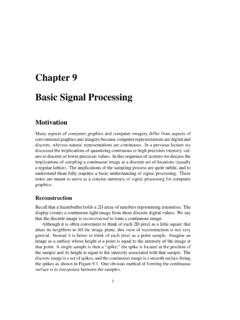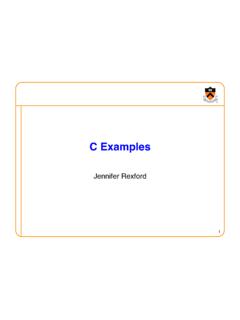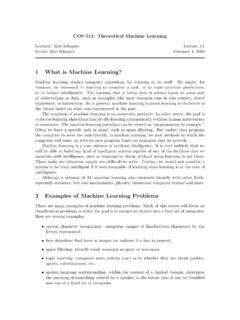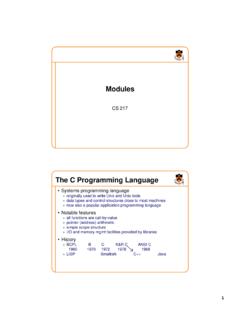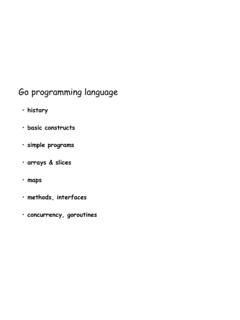Transcription of 1 What is Machine Learning? - Princeton University
1 COS 511: Theoretical Machine LearningLecturer: Rob SchapireLecture #1 Scribe: Rob SchapireFebruary 4, 20081 What is Machine Learning? Machine learning studies computer algorithms for learningto do stuff. We might, forinstance, be interested in learning to complete a task, or tomake accurate predictions,or to behave intelligently. The learning that is being done is always based on some sortof observations or data, such as examples (the most common case in this course), directexperience, or instruction. So in general, Machine learning is about learning to do better inthe future based on what was experienced in the emphasis of Machine learning is onautomaticmethods. In other words, the goal isto devise learning algorithms that do the learning automatically without human interventionor assistance. The Machine learning paradigm can be viewed as programming by example. Often we have a specific task in mind, such as spam filtering.
2 But rather than programthe computer to solve the task directly, in Machine learning , we seek methods by which thecomputer will come up with its own program based on examples that we learning is a core subarea of artificial intelligence. It is very unlikely that wewill be able to build any kind of intelligent system capable of any of the facilities that weassociate with intelligence, such as language or vision, without using learning to get tasks are otherwise simply too difficult to solve. Further, we would not consider asystem to be truly intelligent if it were incapable of learning since learning is at the core a subarea of AI, Machine learning also intersects broadly with other fields,especially statistics, but also mathematics, physics, theoretical computer science and Examples of Machine learning ProblemsThere are many examples of Machine learning problems. Much of this course will focus onclassification problems in which the goal is to categorize objects into a fixed set of are several examples: optical character recognition: categorize images of handwritten characters by theletters represented face detection: find faces in images (or indicate if a face is present) spam filtering: identify email messages as spam or non-spam topic spotting: categorize news articles (say) as to whether they are about politics,sports, entertainment, etc.
3 Spoken language understanding: within the context of a limited domain, determinethe meaning of something uttered by a speaker to the extent that it can be classifiedinto one of a fixed set of categories medical diagnosis: diagnose a patient as a sufferer or non-sufferer of some disease customer segmentation: predict, for instance, which customers will respond to a par-ticular promotion fraud detection: identify credit card transactions (for instance) which may be fraud-ulent in nature weather prediction: predict, for instance, whether or not it will rain tomorrow(In this last case, we most likely would actually be more interested in estimating theprob-abilityof rain tomorrow.)Although much of what we will talk about will be about classification problems, thereare other important learning problems. In classification, we want to categorize objects intofixed categories. In regression, on the other hand, we are trying to predict a real value.
4 Forinstance, we may wish to predicthow muchit will rain tomorrow. Or, we might want topredict how much a house will sell richer learning scenario is one in which the goal is actually to behave intelligently, orto make intelligent decisions. For instance, a robot needs to learn to navigate through itsenvironment without colliding with anything. To use Machine learning to make money onthe stock market, we might treat investment as a classification problem (will the stock goup or down) or a regression problem (how much will the stock goup), or, dispensing withthese intermediate goals, we might want the computer to learn directly how to decide tomake investments so as to maximize wealth. A final example is game playing where thegoal is for the computer to learn to play well through Goals of Machine learning ResearchThe primary goal of Machine learning research is to develop general purpose algorithms ofpractical value.
5 Such algorithms should be efficient. As usual, as computer scientists, wecare about time and space efficiency. But in the context of learning , we also care a greatdeal about another precious resource, namely, the amount ofdata that is required by thelearning algorithms should also be as general purpose as possible . We are looking foralgorithms that can be easily applied to a broad class of learning problems, such as thoselisted primary importance, we want the result of learning to be a prediction rule that is asaccurate as possible in the predictions that it , we may also be interested in the interpretability of the prediction rulesproduced by learning . In other words, in some contexts (suchas medical diagnosis), we wantthe computer to find prediction rules that are easily understandable by human mentioned above, Machine learning can be thought of as programming by example.
6 What is the advantage of Machine learning over direct programming? First, the results ofusing Machine learning are often more accurate than what canbe created through directprogramming. The reason is that Machine learning algorithms are data driven, and are ableto examine large amounts of data. On the other hand, a human expert is likely to be guidedby imprecise impressions or perhaps an examination of only arelatively small number learningexamplenewexamplestraininglabele dFigure 1: Diagram of a typical learning , humans often have trouble expressing what they know, but have no difficultylabeling items. For instance, it is easy for all of us to labelimages of letters by the characterrepresented, but we would have a great deal of trouble explaining how we do it in reason to study Machine learning is the hope that it will provide insights intothe general phenomenon of learning .
7 Some of the questions that might be answered include: What are the intrinsic properties of a given learning problem that make it hard oreasy to solve? How much do you need to know ahead of time about what is being learned in orderto be able to learn it effectively? Why are simpler hypotheses better?This course is focused ontheoreticalaspects of Machine learning . Theoretical machinelearning has much the same goals. We still are interested in designing Machine learningalgorithms, but we hope to analyze them mathematically to understand their efficiency. Itis hoped that theoretical study will provide insights and intuitions, if not concrete algo-rithms, that will be helpful in designing practical algorithms. Through theory, we hopeto understand the intrinsic difficulty of a given learning problem. And we also attempt toexplain phenomena observed in actual experiments with learning course emphasizes the study of mathematical models of Machine learning , as wellas the design and analysis of Machine learning algorithms.
8 Topics include: the number of random examples needed to learn; the theoretical understanding of practical algorithms, including boosting and support-vector machines; on-line learning from non-random examples (including portfolio selection); estimating a probability distribution from samples; reinforcement learning or game theory (probably not time for both).3examplelabeltrainant bat+dolphin leopard+sea lion zebra+shark mouse+chicken testtigertunaplatypusFigure 2: A tiny learning two most closely related computer science courses at Princeton are 402 (focusingon core areas of artificial intelligence) and 424 (focusing on techniques for the effective useof data, including Machine learning , statistics and data mining ). In comparison to 511which focuses only on the theoretical side of Machine learning , both of these offer a broaderand more general introduction to Machine learning broaderboth in terms of the topicscovered, and in terms of the balance between theory and A Typical learning ProblemIn a typical learning problem, such as optical character recognition, our goal is to createa system that can read handwritten characters.
9 But rather than attacking the problemdirectly, we start by gathering a large collection of examples of images of characters whichare labeled as to the letter or digit that they represent. We then feed these examples toa general purpose learning algorithm which in turn producesa prediction rule capable (wehope) of classifying new images. The entire process is depicted in Figure get a feeling for learning , we looked first at the learning problem shown in Figure , examples are labeled positive ( + ) or negative ( ). In this case, the pattern isthat land mammals are positive, and others negative. Actually, the pattern is kind ofhazy, since it might be, for instance, that the positive examples are animals that don t livein the ocean and don t lay eggs. Thus, test examples tiger and tuna are positive andnegative, respectively, but we can only guess the correct label of platypus (an egg-layingmammal).
10 The second example is shown in Figure 3. Initially, exampleswere presented as animalnames, and the problem seemed difficult. When the animal namesare rewritten in terms ofthe position in the alphabet of each letter of each name, the pattern becomes more evident,namely, that an example is positive if and only if the third letter has an odd position in thealphabet (for instance, the third letter of elephant is e which is the fifth letter of thealphabet, so elephant is a positive example).4examplelabeltrainaardvark 1 1 18 4 22 1 18 11 cow 3 15 23+giraffe 7 9 18 1 6 6 5 termite 20 5 18 13 9 20 5 oyster 15 25 19 20 5 18+dove 4 15 22 5 spider 19 16 9 4 5 18+dog 4 15 7+elephant 5 12 5 16 8 1 14 20+testrabbit 18 1 2 2 9 20frog 6 18 15 7kangaroo 11 1 14 7 1 18 15 15 Figure 3: A second toy learning problem.
